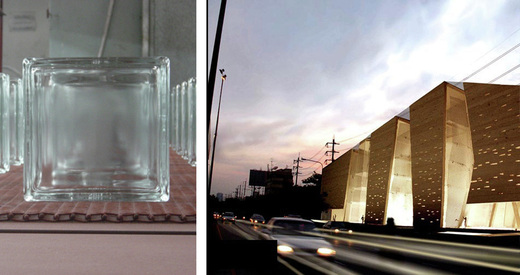Glass Block Building
Our designs always involve thinking outside the box. In the case of the Chaang Keew Glass Block Co., we aspired to think outside the glass box, or glass brick for that matter. Glass blocks, by and large, have become outmoded. They are identified with kitschy late 80s atriums, restrooms, airport vestibules, etc. Our design interests were in line with the client’s in this instance: how to we add value to the glass block?
First of all, we sought to liberate the glass box from the rectilinear or arced wall to which it has historically been consigned, hoping thereby to let a more free-formed articulation resignify the glass block as a dynamic and decorative architectural element. We began by removing its white rubber casing and, rather than combine the blocks with mortar, we treated the glass block instead like a gem worthy of exhibition by nesting each block into a steel frame. Without the surrounding mortar or rubber casing, we found the glass blocks actually shine and sparkle—like gems—when oriented in a variety of positions. We then devised a metal, amorphous steel grid that would allow the glass blocks to coalesce together into a building skin of brilliant undulating waves. It would be design alchemy—converting kitsch intro crystal, junk into jewels.
But, this building was intended for Bangkok. An undulating crystalline blob in the hottest city on earth would entail a tremendous air conditioning load. And, as Shakespeare’s Henry IV said, ‘when things seldom come they wished for come; and nothing pleaseth like rare accident.’ We did not want the architecture to look like a rhinestone clutch or to have the energy footprint of mega-mall. So, we coordinated our glass block innovation with our programmatic goals. We wanted to avoid the neutralizing expansiveness of an open plan, and chose instead to break up the program into smaller vertical communities that could be connected by interpenetrating circulation canyons. We simply extruded the building footprint, sloped the roof, and introduced a series of bisecting fissures according to the company’s program requirements. The exterior walls would be solid, stone surfaces inscribed with long horizontal bands of light-inducing glass blocks, while the interior fissures would be composed of the dazzling glass block curtains we first devised. The result would be an architectural and PR paean to the glass block: the monolithic and rectilinear stone facades with its sharp linear streaks of radiant glass block on the exterior, along with the dynamically formed crystal canyons on the interior.
First of all, we sought to liberate the glass box from the rectilinear or arced wall to which it has historically been consigned, hoping thereby to let a more free-formed articulation resignify the glass block as a dynamic and decorative architectural element. We began by removing its white rubber casing and, rather than combine the blocks with mortar, we treated the glass block instead like a gem worthy of exhibition by nesting each block into a steel frame. Without the surrounding mortar or rubber casing, we found the glass blocks actually shine and sparkle—like gems—when oriented in a variety of positions. We then devised a metal, amorphous steel grid that would allow the glass blocks to coalesce together into a building skin of brilliant undulating waves. It would be design alchemy—converting kitsch intro crystal, junk into jewels.
But, this building was intended for Bangkok. An undulating crystalline blob in the hottest city on earth would entail a tremendous air conditioning load. And, as Shakespeare’s Henry IV said, ‘when things seldom come they wished for come; and nothing pleaseth like rare accident.’ We did not want the architecture to look like a rhinestone clutch or to have the energy footprint of mega-mall. So, we coordinated our glass block innovation with our programmatic goals. We wanted to avoid the neutralizing expansiveness of an open plan, and chose instead to break up the program into smaller vertical communities that could be connected by interpenetrating circulation canyons. We simply extruded the building footprint, sloped the roof, and introduced a series of bisecting fissures according to the company’s program requirements. The exterior walls would be solid, stone surfaces inscribed with long horizontal bands of light-inducing glass blocks, while the interior fissures would be composed of the dazzling glass block curtains we first devised. The result would be an architectural and PR paean to the glass block: the monolithic and rectilinear stone facades with its sharp linear streaks of radiant glass block on the exterior, along with the dynamically formed crystal canyons on the interior.

